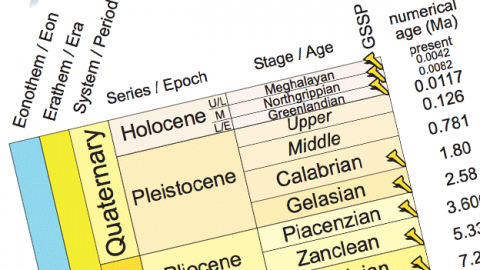The International Commission on Stratigraphy (ICS) has defined a new division in geologic time that will now appear on all official charts depicting Earth’s geological past. This is the Meghalayan Age, which has been defined as the most recent age of the Holocene Epoch, extending from 4,200 years ago until the present.
The Meghalayan Age began at the time when agricultural societies around the world experienced an abrupt and critical mega-drought and cooling. Agricultural-based societies that developed in several regions after the end of the last Ice Age were severely affected by the 200-year long climatic event that resulted in the collapse of civilizations and human migrations in Egypt, Greece, Syria, Palestine, Mesopotamia, the Indus Valley, and the Yangtze River Valley. Evidence of the 4.2 ka event has been found on all seven continents.
The Meghalayan Age is unique among the many intervals of the geologic timescale in that its beginning coincides with a global cultural event produced by a global climatic event, says Stanley Finney, professor of geological sciences at Long Beach State University and Secretary-General of the International Union of Geological Sciences (IUGS), which ratified the ICS proposal.
The ICS, which is responsible for standardizing the Geologic Time Scale, approved the definition of the beginning of the youngest unit of the scale on the basis of the timing of this event. It also approved proposals for two other ages: the Middle Holocene Northgrippian Age and the Early Holocene Greenlandian Age, with beginnings defined at climatic events that happened about 8,300 years and 11,700 years ago, respectively. The three ages constitute the Holocene Epoch, which represents the time since the end of the last Ice Age. The commission then forwarded these proposals to its parent body, the IUGS, for consideration, and the executive committee of IUGS voted unanimously to ratify them on 14 June 2018. The ICS released an updated geologic timescale on 13 July 2018.

the new stages in the Holocene (Image: ICS)
Units of the Geologic Time Scale are based on sedimentary strata that have accumulated over time and contain within them sediment types, fossils and chemical isotopes that record the passage of time as well as the physical and biological events that produced them. The three new ages of the Holocene Epoch are represented by a wealth of sediment that accumulated worldwide on the sea floor, on lake bottoms, as glacial ice, and as calcite layers in stalactites and stalagmites. Those intervals of sedimentary strata on which the ages are based are referred to as stages, and together the strata of three new stages comprise the Holocene Series. The lower boundary of the Greenlandian and Northgripppian stages are defined at specific levels in Greenland ice cores. The lower boundary of the Meghalayan Stage is defined at a specific level in a stalagmite from a cave in the north-east Indian state of Meghalaya, which gave its name to the new age. The ice cores and the stalagmite are now identified as international geostandards, and have been placed in protected archives accessible for further study.

Portion of the Indian stalagmite that contains the layers chosen to define the beginning of the Late Holocene Meghalayan Age, 4200 years ago.
Image: ICS
However, some researchers have objected to the Meghalayan’s creation, especially as there are continuing discussions about the definition of a new geological period based on human activity – the “Anthropocene”. Scientists like Professor Mark Maslin from University College London who have been involved in the Anthropocene debate have expressed concern about the abrupt imposition of this new age. However, although the concept of an Anthropocene has been popularised in environmental circles as a symbol of the harm humans are causing to the planet, it too is a source of controversy. Many scientists have argued that, while the name is eye-catching, it lacks the geological evidence to back it up.
This article is based on material on the ICS website and on articles in the Independent, on the BBC News website and on the Science News website. The new edition of the International Chronostratigraphic Chart can be downloaded here. As well as the new ages in the Holocene, the the new edition of the chart contains updates to the Cambrian Period.
Bill Gray